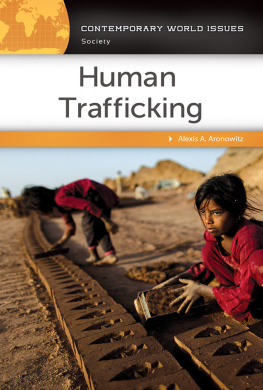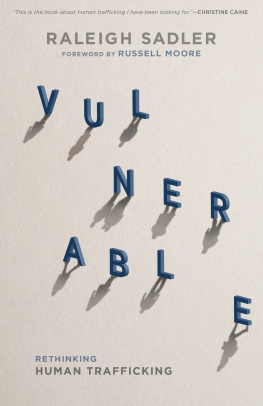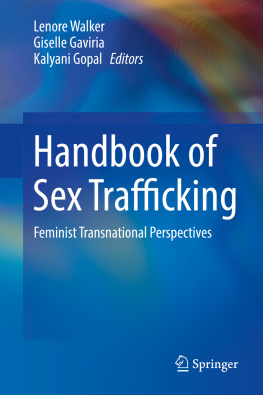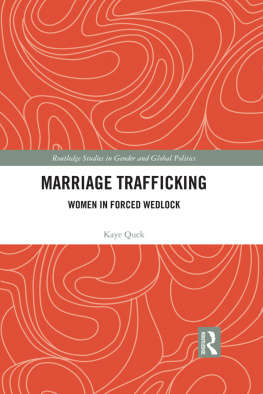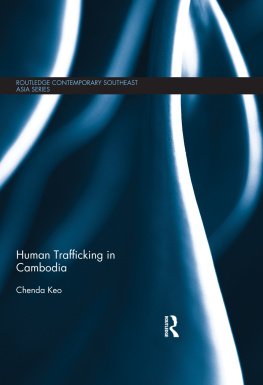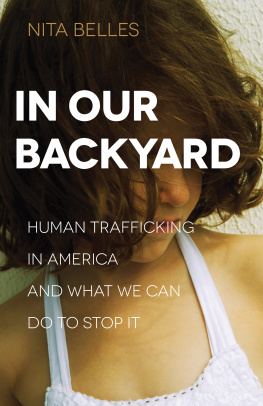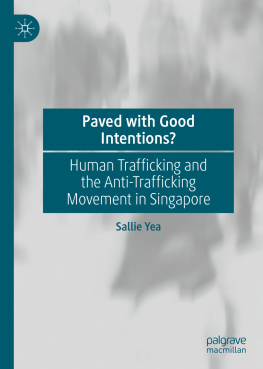Human Trafficking
Recent Titles in the
CONTEMPORARY WORLD ISSUES Series
The Minimum Wage: A Reference Handbook
Oren M. Levin-Waldman
Juvenile Justice: A Reference Handbook, second edition
Donald J. Shoemaker and Timothy W. Wolfe
The Global Water Crisis: A Reference Handbook
David E. Newton
Youth Substance Abuse: A Reference Handbook
David E. Newton
Global Pandemic Threats: A Reference Handbook
Michael C. LeMay
Same-Sex Marriage: A Reference Handbook, second edition
David E. Newton
DNA Technology: A Reference Handbook, second edition
David E. Newton
Modern Sport Ethics: A Reference Handbook, second edition
Angela Lumpkin
Marijuana: A Reference Handbook, second edition
David E. Newton
Gun Control in the United States: A Reference Handbook, second edition
Gregg Lee Carter
The Right to Die: A Reference Handbook
Howard Ball
Student Debt: A Reference Handbook
William Elliott III and Melinda K. Lewis
Food Safety: A Reference Handbook, third edition
Nina E. Redman and Michele Morrone
Books in the Contemporary World Issues series address vital issues in todays society such as genetic engineering, pollution, and biodiversity. Written by professional writers, scholars, and nonacademic experts, these books are authoritative, clearly written, up-to-date, and objective. They provide a good starting point for research by high school and college students, scholars, and general readers as well as by legislators, businesspeople, activists, and others.
Each book, carefully organized and easy to use, contains an overview of the subject, a detailed chronology, biographical sketches, facts and data and/or documents and other primary source material, a forum of authoritative perspective essays, annotated lists of print and nonprint resources, and an index.
Readers of books in the Contemporary World Issues series will find the information they need in order to have a better understanding of the social, political, environmental, and economic issues facing the world today.
CONTEMPORARY WORLD ISSUES
Human Trafficking
A REFERENCE HANDBOOK
Alexis A. Aronowitz
Copyright 2017 by ABC-CLIO, LLC
All rights reserved. No part of this publication may be reproduced, stored in a retrieval system, or transmitted, in any form or by any means, electronic, mechanical, photocopying, recording, or otherwise, except for the inclusion of brief quotations in a review, without prior permission in writing from the publisher.
Human Trafficking: A Reference Handbook
Library of Congress Cataloging in Publication
Control Number: 2016052706
ISBN: 978-1-4408-3484-4
EISBN: 978-1-4408-3485-1
21 20 19 18 17 1 2 3 4 5
This book is also available as an eBook.
ABC-CLIO
An Imprint of ABC-CLIO, LLC
ABC-CLIO, LLC
130 Cremona Drive, P.O. Box 1911
Santa Barbara, California 93116-1911
www.abc-clio.com
This book is printed on acid-free paper 
Manufactured in the United States of America
This book is dedicated to Gert-Jan, Julius,
Marilyn, Jay, and Andre
and their children, Jenna, Jeboa, Shavon,
Tony, and Jason
my sources of love, support, and friendship,
past, present, and future
Human Trafficking
Contents
| Ronald Weitzer |
| Joanne van der Leun |
| Aaron Cohen |
| Elif Isitman |
| Patsy Sorensen and Klaus Vanhoutte |
| Ivonne van de Kar |
| Rebecca Surtees |
| Dina Siegel |
| Glynn Rankin |
Recruiters came to a town in Syria offering paid work in restaurants and hotels in Lebanon. A young woman, anxious to leave her war-torn country, accepted the offer. Upon arriving in Lebanon, she was forced into prostitution with more than 70 other women and girls, many of whom were from Syria. The victims were locked in hotels, raped and tortured, and forced to service as many as 20 clients each day.
Halfway around the world, a Bangladeshi man was brought to a palm oil plantation seeking work. His passport was confiscated by the contracting company that withheld his salary to pay for his recruitment fees.
In Canada, a 13-year-old adolescent was deceived by a young girl she had met online. The girl, her boyfriend, and another man forced the adolescent into prostitution and sold her to clients in cities around Canada (U.S. Department of State, 2016).
There are an estimated 21 million people who are victims of forced labor in the world today (ILO, 2012). The United Nations identifies human trafficking as the third most profitable crime after drugs and arms trafficking, estimating that it generates US$32 billion in profit for the traffickers. It is not just a problem affecting developing nations. In 2016, the U.S. Department of States Office to Monitor and Combat Trafficking in Persons identified 188 countries with a significant trafficking problem (U.S. Department of State, 2016). The United Nations found that between 2010 and 2012, victims of 152 different nationalities were identified in 124 countries worldwide (UNODC, 2014).
The image of a trafficked victim is one of foreign women being brought into a country and enslaved in the sex industry. Sex trafficking is perhaps the most well-known form of trafficking, but it is not the only form. Where criminals can profit off of the exploitation of a persons labor, human trafficking will thrive. Exploitation occurs not only in the unregulated sex sector, but also in the more common and legitimate sectors such as construction, food service, the restaurant and hotel industry, domestic service, agriculture, and fishing. Other less common forms of human trafficking have been identified. These include the trafficking of persons for the purpose of organ removal, forced begging or other criminal activities, and children for use as child soldiers and child brides (Aronowitz, 2009).
Who are those who fall prey to traffickers and why is it so difficult to identify victims of trafficking? They are rarely ideal victims who fit a perfect victim profile (Christie, 1986). They sometimes agree to travel abroad using false identity papers and know they will be residing and working illegally in the country of destination. Some even know they are going to work in prostitution. They are sometimes nationals of the country in which they are exploited. They frequently refuse to cooperate with law enforcement. This picture will vary from country to country as well as within countries across different markets.
And who are the people who so viciously exploit the victims? Studies of victims testimonies, data produced by international organizations and government agencies, newspaper articles, and police files show a varied picture. The image of traffickers as dark, swarthy men may be more fiction than fact. The United Nations reports a growing involvement of women in the business of human trafficking (UNODC, 2012; 2014). Studies of police files also show differences in the level of organization and roles of traffickers. A trend that is being observed of this book.
When the author began her career in the field of human trafficking for the United Nations Interregional Crime and Justice Research Institute (UNICRI) in 2000, there was limited awareness of human trafficking. Researchers were being told by national law enforcement agencies in different countries that foreign women were working illegally as prostitutes but that human trafficking did not exist. No one questioned how these young women and girls were ablewithout helpto migrate from villages in their country to destinations thousands of miles away and establish themselves as prostitutes in a country with which they were unfamiliar and did not speak the language.

